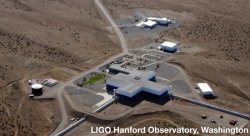
University Calendar
Update on the Search for Gravitational Waves

- When: February 11 at 10:30 a.m.
- Where: CELS lecture hall, room 120
Gravitational Waves
100 years after Einstein predicted the existence of gravitational waves, the National Science Foundation gathers scientists from Caltech, MIT and the LIGO Scientific Collaboration to update the scientific community on efforts to detect them. Join us at the above space-time coordinates for a live-stream of the NSF press conference. We will have a brief Q&A following the live-stream at ~11:00am featuring Mathematical Sciences faculty member Marc Favata.
At 11:45 a.m. there will be a talk by visiting faculty candidate Michele Heurs on LIGO-related research: Nonclassical laser interferometry for gravitational wave astronomy. All are welcome.
About the Laser Interferometer Gravitational-wave Observatory (LIGO)
LIGO is a system of two identical detectors carefully constructed to detect incredibly tiny vibrations from passing gravitational waves. It was conceived and built by MIT and Caltech researchers, funded by the National Science Foundation, with significant contributions from other U.S. and international partners. The twin detectors are located in Livingston, Louisiana, and Hanford, Washington. Research and analysis of data from the detectors is carried out by a global group of scientists, including the LIGO Scientific Collaboration (which includes Montclair State) and the VIRGO Collaboration.